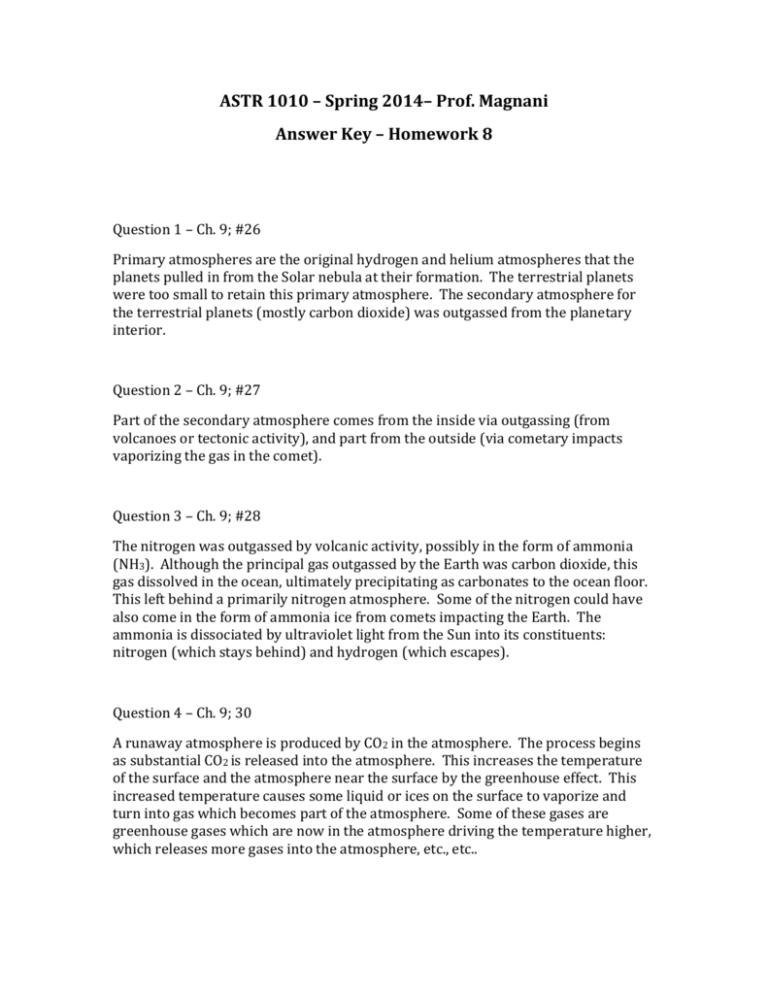ASTR1010_HW08
advertisement

ASTR 1010 – Spring 2014– Prof. Magnani Answer Key – Homework 8 Question 1 – Ch. 9; #26 Primary atmospheres are the original hydrogen and helium atmospheres that the planets pulled in from the Solar nebula at their formation. The terrestrial planets were too small to retain this primary atmosphere. The secondary atmosphere for the terrestrial planets (mostly carbon dioxide) was outgassed from the planetary interior. Question 2 – Ch. 9; #27 Part of the secondary atmosphere comes from the inside via outgassing (from volcanoes or tectonic activity), and part from the outside (via cometary impacts vaporizing the gas in the comet). Question 3 – Ch. 9; #28 The nitrogen was outgassed by volcanic activity, possibly in the form of ammonia (NH3). Although the principal gas outgassed by the Earth was carbon dioxide, this gas dissolved in the ocean, ultimately precipitating as carbonates to the ocean floor. This left behind a primarily nitrogen atmosphere. Some of the nitrogen could have also come in the form of ammonia ice from comets impacting the Earth. The ammonia is dissociated by ultraviolet light from the Sun into its constituents: nitrogen (which stays behind) and hydrogen (which escapes). Question 4 – Ch. 9; 30 A runaway atmosphere is produced by CO2 in the atmosphere. The process begins as substantial CO2 is released into the atmosphere. This increases the temperature of the surface and the atmosphere near the surface by the greenhouse effect. This increased temperature causes some liquid or ices on the surface to vaporize and turn into gas which becomes part of the atmosphere. Some of these gases are greenhouse gases which are now in the atmosphere driving the temperature higher, which releases more gases into the atmosphere, etc., etc.. Question 5 – Ch. 9; #31 The natural greenhouse effect has been around for a couple billion years and raises the Earth’s temperature by about 30-35 K. This raises the average temperature of the Earth above the freezing point of water allowing us to have large amounts of liquid water (necessary for life) on the surface. Questions 6; Ch. 9; #32 Plants take in carbon dioxide and give off oxygen. Over time, this built up the oxygen in the Earth’s atmosphere. See Figure 9.6. Question 17 – Ch. 9; #36 The solar wind is a stream of charged particles emitted by the Sun that flows at high speed through the Solar System. The Earth’s magnetic field effectively shields most of the Earth from the solar wind, funneling its particles to the North and South polar regions where they cause auroras. The solar wind does push down on the Earth’s ionosphere and causes disturbances in radio communications. The connection between the solar wind and terrestrial climate has long been surmised but the details of the connection have never been clearly determined. However, if massive solar outbursts called coronal mass ejections overload the Earth’s magnetic field, then there could be problems for electrical equipment on the surface. Items like transformers could be knocked out. Finally, the solar wind does strip some of the Earth’s outer exosphere. Question 8; Ch. 9; #40 Venus rotates so slowly that the Hadley circulation does not break up into zonal winds, but, instead, carries air from the equator to the poles and back to equilibrate the surface temperature. See Figure 9-11. The runaway greenhouse effect of the atmosphere dwarfs the contribution from solar heating so there is little difference between the “day” and “night” sides of the planet. Question 9 – Ch. 9; #45 Assume the surface area of your head is 0.05 square meters (that’s a blockhead with each side about 9 inches long). Maybe we should take half that as a better estimate: 0.025 m2, Pressure is force per area, so force is pressure times area: F = (1 x 105) x (0.025) = 2500 Newtons F = ma so m = F/a M = 2500/9.8 = 255 kg A bit more than 4 kangaroos would have to sit on your head (good visual). We are not crushed by this pressure because the pressure is equilibrated inside our bodies with the outside surroundings. Question 10 – Ch.9; #52 a) Basically, mava2 = mbvb2 where a and b are two different species. So ma/mb = vb2/va2 let “a” be 02 and “b” be CO2 16/22 = vb2/va2 vb/va = 0.85 The speed of the CO2 is only 85% that of the O2 b) No, the ratio does not depend on the temperature. The velocities each depend on the temperature (to the ½ power), but we are looking at a ratio so the dependence cancels out and the ratio is unaffected by the temperature. Question 11 – Ch. 9; #53 How high would a mass of 1.033 x 104 kg/m2 have to be so that its density was 1.225 kg/m3? If you look at the units we have Mass/square meter = density x height So, solve for the height = 8400 m = 8.4 km Given that the Earth’s atmosphere goes up at least 200 km, this tells you how “packed” close to the ground most of it is. Think about it. Question 12 – Ch. 9; #54 6.4 millibars = 0.0064 bars It’s hard to see from Figure 9.7 but it would be > 36 km Question 13 – Ch.9; #55 Atmospheric pressure on Venus is 92 bars 1 bar ~ 10 m of depth, so you feel the same pressure as on the surface of Venus as you do when you are about 920 meters under sea level. That’s about 1 km underwater.








